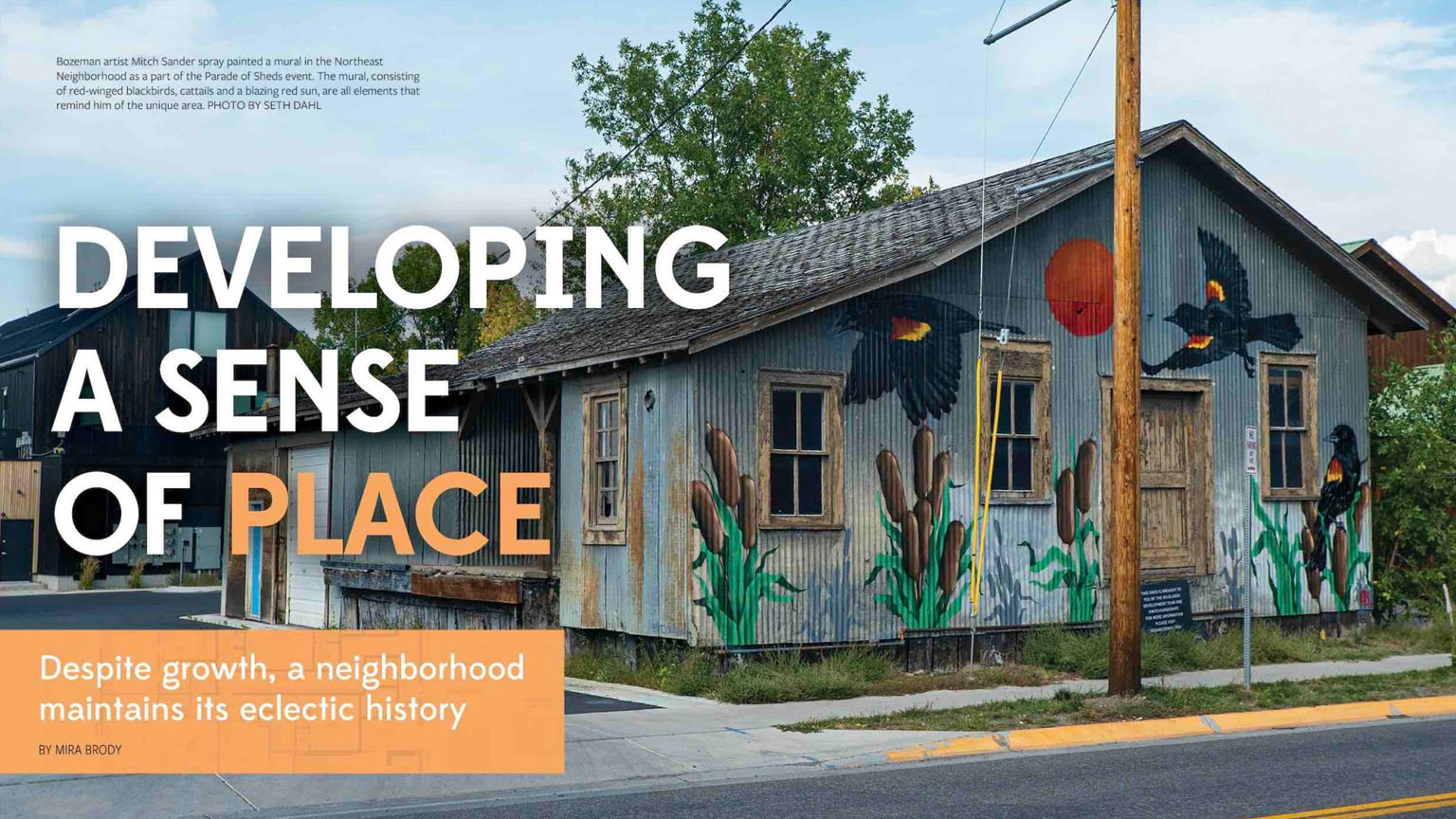By Mira Brody
Bozeman artist Mitch Sander spray paints the finishing vibrant lines of an orange-red sun tinted by wildfire smoke on the side of a corrugated tin shed in Bozeman’s Northeast Neighborhood. The sun shines down on three painted red-winged blackbirds and stalks of brown cattails, and passersby walking to and from neighboring Wild Crumb Bakery watch Sander as he works—some silently, some striking up conversations with the artist before they grab a pastry and head back home, to work, or to recreate in the nearby Bridger Mountains.
The mural Sander is working on is a part of the Parade of Sheds event hosted by the Northeast Neighborhood Association, and the shed itself stands on the site of a new infill development project called The Wildlands that will soon break ground among the historic structures of the northeast side.
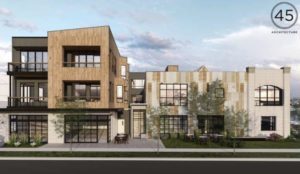

A current rendering shows The Wildlands development project, which includes brick, wood and an uneven parapet where the roofline meets the sky. It will offer 12 apartments, three business spaces, and public areas to sit and gather around the existing Wild Crumb Bakery. RENDERING BY 45 ARCHITECTURE
“It’s a lot better just for larger surfaces, it allows me to be more loose with my painting,” said Sander of his chosen medium. The self-taught acrylic painter has been a part of Bozeman’s art scene since he moved here from his hometown of Bismarck, North Dakota, in 2009. “I kind of tend to paint things that are very clean-cut, very straight, very round, that sort of thing, and spray painting is more of a free form … It’s easier to express a lot more, quicker.”
This neighborhood has taken a similar creative approach to growth. They make an effort to protect their history and artisan culture and are doing so by communicating with developers as real estate booms in Gallatin Valley. The Wildlands is one such project. It’s a collaborative effort between Outlaw Real Estate Partners, a southwest Montana real estate company, and 45 Architecture of Bozeman, and aims to build with creativity and intention.
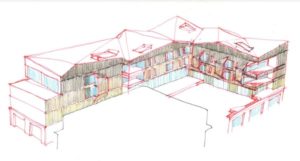

Initial rough sketches by architect Jeff Lusin depict an early design concept for The Wildlands. ILLUSTRATION BY JEFF LUSIN
“The goal for us with this is to find a way to integrate living and additional commercial opportunities in this neighborhood while responding to its unique, eclectic nature,” said Eric Ladd, owner of OREP. “Inspirations for this project really came from its surroundings. The project will be an eclectic, polished but fun building and should support and celebrate the existing template that’s already there.”
Ladd calls The Wildlands “low-scale and responsible,” and will yield 12 apartments and three more commercial areas. It will add improvements to existing public spaces around Wild Crumb and Fink’s Delicatessen, creating more room for community gathering. The project is slated to begin in late 2021.
A Cultural Enclave
The Parade of Sheds is a quirky celebration and perhaps the best way to introduce the Northeast Neighborhood to those unfamiliar with the cultural enclave. The event is a play on the traditional Parade of Homes that many cities celebrate, during which residents self-tour often large, newly built homes in their community. The Parade of Sheds, however, celebrates practical and idiosyncratic designs such as drought-friendly gardens, a giant tree house or an old, painted tin barn.
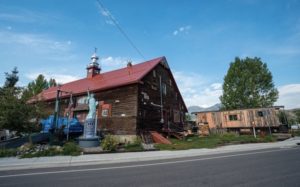

The Northeast Neighborhood is known for its unique exteriors and is referred to as the artistic hub of Bozeman. PHOTO BY SETH DAHL
“It’s designed to be a fun community gathering,” said Reno Walsh, president of the Northeast Neighborhood Association, known as NENA. “I think it’s an important community appreciation event and it’s an attempt to keep the north side funky and hold onto that eclectic nature, and I think it does that.”
Walsh, who is raising his family on the northeast side, appreciates the small size and familiar faces at the event. Nearly 100 attendees turned out for the parade and many more for the self-guided shed tours. “Now I Know,” a solo music project composed by Montana State University emeritus Chris Jenkins, played live music for passersby.
The Northeast Neighborhood has not only embraced its culture through quirky residential exteriors and intimate neighborhood events, but also through its support of small local businesses and artists, such as Wild Crumb and Fink’s, as well as Treeline Coffee Roasters, Alter Bikes, Tinworks Art, Echo Arts and a variety of other locally owned shops that call the area home.
In 2005, the Northeast Neighborhood was designated by the City of Bozeman as an Urban Renewal District, which collects city taxes to fund neighborhood improvements. This designation has made many of these development projects a reality and allowed for this variety of businesses to call the area home, making for a unique mix of residences as well as offices, eateries and breweries.
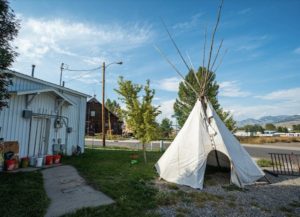

A teepee stands in front of a backdrop of the Northern Pacific Railroad and Bridger Mountains on the northeast side. PHOTO BY SETH DAHL
Developers of The Wildlands project have presented at NENA’s biannual meeting as well as the association’s town hall meetings, which consist of a 10-minute presentation by the developers followed by a Q&A session. It’s an effective way to engage the community with development projects and provide them with a voice, Walsh explains. Some concerns voiced by neighbors include window placement in the new building, as well as area parking. Walsh speaks candidly about the feeling of discomfort that some neighbors have toward growth and development, a complexity many longtime Montanans have grappled with as their beloved town is discovered.
“We all know what it was like 25 years ago,” Walsh said. “We know it was good but we don’t know what it’s going to be like in the future and that unknown is uncomfortable. [The developers] are being transparent, so that goes a long ways. But in the end it’s development, it’s change and change can be difficult and it has an impact on our daily lives.”
Walsh is urging residents to maintain open lines of communication. “Something we can do is address the policies that encourage and manage planning development,” he said. “I encourage people to get involved with their local neighborhood association.”
Although Bozeman has witnessed significant growth in recent years, one thing that hasn’t changed over the decades is the reason so many come here—opportunity and quality of life. With easy access to recreation, views and friendly community, the Gallatin Valley has always attracted adventure seekers and those looking for a better life.
For Jeff Lusin, lead architect of The Wildlands and owner and principal of 45 Architecture in Bozeman, the process of collecting existing characteristics and sculpting them into a new development project began at the Gallatin History Museum.
A Hub for Adventure
In the 1800s, Bozeman’s northeast side was a bustling hub of agriculture. Story Mill and the Lehrkind Brewery provided employment to many of the area’s blue-collar workers and because of access to the Northern Pacific Railroad, surrounding farmers used the trolley line to transport produce to the train station to be shipped throughout the country.
For its part, 45 Architecture has been developing projects in the area for 15 years, including Van Winkle Stadium at Montana State University and Neptune’s Taphouse and Eatery in Livingston. Lusin joined as owner and principal just over five years ago. As a Bozeman native who spent his youth in the neighborhood attending Hawthorne Elementary School, channeling this history and character into a new development project was more than just another job for him—it’s been a project of passion.
“How do we take all that rich history of the railroad, the mills, the brewery—it’s kind of wild right? It’s the Wild West,” Lusin said. “So if we can create a location that’s the pit stop to the outdoors and to adventure, that’s The Wildlands.”
“It’s hard to replicate character,” Ladd said. “Character is usually earned through time and place, and so as you drive around the neighborhood, you’re inspired by things from fences made of skis, to their prized shed tour and chicken coops. This neighborhood also has a deep history of the railroad and all the [grain] storage buildings, and all those elements. Our architects have studied that.”
Lusin utilized brick for the first level, wood on floors two and three, and a varied parapet creating a unique connection between the ground and the sky. The attention given to the Earth-sky connection, he says, is essential because so much of our culture in Montana is looking up at the vast celestials and mountainscapes around us.
“When you put a feeling behind a building … in a place that’s so artist-centered and really kind of eclectic in the uniqueness, you can create your own stamp,” said Lusin. “That’s the power of the Northeast Neighborhood—it allows people to be really as creative as they want.”
Much like the old brick buildings that grace Bozeman’s Historic Downtown making for its recognizable skyline, The Wildlands structure, Lusin says, is intended to provide a sense of familiarity and permanence that stands the test of time. He describes the vast walls they designed on the building with the specific intention of them becoming a mural space. Although specific art has not yet been determined, the walls are intended to stand as a blank canvas on which local creatives can make their mark.
While The Wildlands project will welcome visitors and residences soon enough, allowing it to find its place in Bozeman’s storied history, Lusin says, will be a longer, more organic process.
“How do we create something that really does stand the test of time as well so that the building itself can have enough pride and importance …?” asks Lusin. “You have to let that integration happen over time.”
Back at his shed-canvas, Sander puts the finishing touches on his own The Wildlands Parade of Sheds mural. He talks about the other projects he’s completed in the area—spray paint pieces at the Starlite Bozeman dance studio or a sketch he did of Misco Mill one afternoon when he felt the inspiration, a power he says the area has over artists.
“I get inspired by something like the old building work [and] the old construction,” Sander said of the northeast side. “New development does happen, but it’s cool when there’s something new, if it can also represent the old stuff. Artists want to be around that old architecture.”




